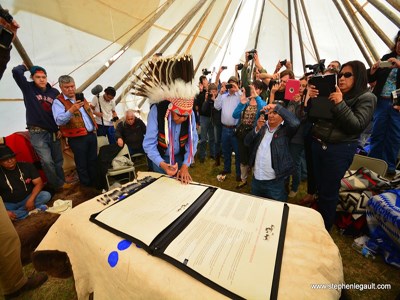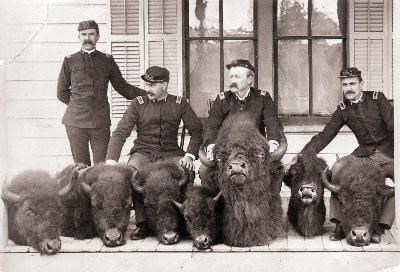Bison and Human Safety
- Bison are wild animals and are unpredictable.
- Maintain a distance of 100 feet (30 m or two bus lengths) from bison.
- When the bison are within 100 feet (30 m) of the road, it is recommended to view theme from inside a vehicle.
- Please use established gravel or paved pull-outs to park vehicles completely off the roadway (all wheels right of the white line). Do not walk or park in the road.
Importance of Indigenous Cultures

Photo by Stephen Legault.
The American bison or buffalo (iinniiwa in Blackfoot, tatanka in Lakota, ivanbito in Navajo, Kuts in Paiute) is the most significant animal to many American Indian nations. For thousands of years, Native Americans relied heavily on bison for their survival and well-being, using every part of the bison for food, clothing, shelter, tools, jewelry and in ceremonies. The decimation of millions of bison in the 1800s was pivotal in the tragic devastation of Indian people and society. Today, bison are central to many American Indian traditions, spiritual rituals and healthy diets, and more than 60 tribes are bringing their sacred Brother Buffalo back to their families, lands and ways of life.
For many Indigenous people, buffalo, a name used for hundreds of years, remains the name of choice for these animals. As a general rule, buffalo is often used in a cultural context while bison is used in a scientific context.
The Brink of Extinction

NPS Photo/Yellowstone National Park
Saving the Last of the Buffalo
In the 1870s and 1880s, hundreds of bison occupied Yellowstone National Park. Despite the presence of the First U.S. Cavalry soldiers the park’s mission to, in part, protect wildlife, poaching of bison continued until Congress passed the Lacey Act in 1894. This legislation authorized the in Yellowstone to prosecute people that were killing or removing wildlife from the park.
In 1905, the American Bison Society (ABS) was formed to support bison recovery efforts, compelling Congress to establish several public bison herds at Wichita Mountains National Wildlife Refuge, the National Bison Range, Sully’s Hill National Game Preserve, Fort Niobrara National Wildlife Refuge, and Wind Cave National Park and President Theodore Roosevelt to establish the Grand Canyon Game Preserve. These efforts help save bison from extinction and the ABS disbanded in the early 1900s having accomplished their mission, however in 2005 the ABS was once again reestablished to help advance the ongoing restoration of bison to our lands and cultures.
Wild and Domestic Bison
Our National Mammal
Bison Bellow
Our National MammalLast updated: March 4, 2024
